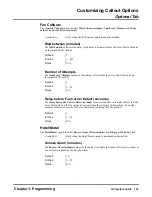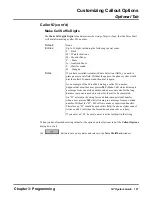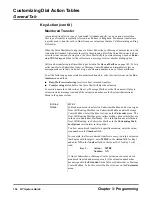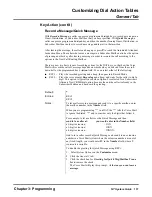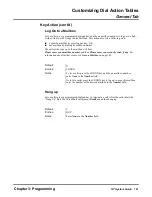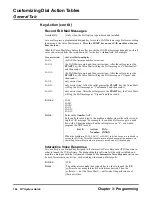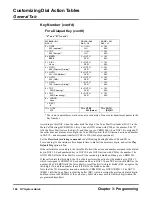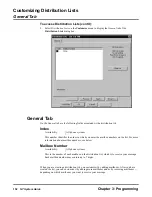
Customizing Dial Action Tables
General Tab
Chapter 3: Programming
NT System Guide
139
Key Action (cont’d)
Directory Dialing by First/Last Name (cont’d)
Entries:
DIRF
DIRL
Notes:
The Voice Mail will perform a screened transfer (TRF) or an
unscreened transfer (UTRF) or a GOTO, when you program a DIRF or
a DIRL in a DAT. When DIRF/DIRL is the Key Action, None should
be the Key Number.
The mailbox numbers must begin with the same digit as the extension
numbers. To let a caller use TRF or UTRF to name-dial a Subscriber,
Guest, or Message Center Mailbox and immediately leave a message,
make sure that you don’t assign extension numbers to these mailboxes.
Whether you choose first-name dialing or last-name dialing, you must
apply the same name-dialing convention to every mailbox name when
you are programming these names. To record mailbox name and/or a
Directory Dialing Message, use the System Administrator Menu in
your phone system.
To enter a mailbox name for each Subscriber, Guest, or Message
Center Mailbox:
1. Select Mailbox Options on the Customize menu.
2. Select Edit on the Mailbox Options drop-down menu.
3. From the Mailbox Types panel of the Mailbox Range dialog box:
a. Check only Subscriber, Guest, and Message Center.
b. Click the OK button.
4. From the General tab:
Enter the name of the mailbox owner in the order you want the
name entered for every mailbox: For last-name dialing, enter the
last name first. Or for first-name dialing, enter the first name first.
To customize the minimum number of letters that a caller must dial,
select System Options on the Customize menu. Then enter the desired
value for Minimum Entry in the Directory Dialing panel of the Gen-
eral 2 tab of the System Options dialog box.
To cause the Voice Mail to play the extension number when it calls the
extension, select System Options on the Customize menu and then
click the Play Extension Number checkbox in the Directory Dialing
panel of the General 2 tab of the System Options dialog box.
The Voice Mail does not complete a name-dialed call when:
Q
name-dialing that extension is not allowed, or the name doesn’t
exist in the Voice Mail directory. After prompting That name is
not listed in the directory, Voice Mail returns the caller to the mes-
sage.
Q
the caller presses only the pound key before returning to the
Instruction Menu for the Call Routing Mailbox.
Q
the caller does not dial the minimum number of letters. The Voice
Mail prompts, You have not entered enough letters, before it
returns the caller to the Directory Dialing Message.
To allow the name-dialing of certain extensions, be sure to enter the
number of the directory list being used in the Directory List to Use box
on the Call Handling tab of the Call Routing Mailbox and in the Direc-
tory List box the Directory option for the called extension/mailbox.
Summary of Contents for NVM-NT
Page 28: ...Table of Contents Chapter 5 Maintenance xxvi NT System Guide ...
Page 130: ...Installing SMDI 102 NT System Guide Chapter 3 Programming ...
Page 146: ...Customizing Caller I D Tables General Tab 118 NT System Guide Chapter 3 Programming ...
Page 156: ...Customizing Callout Options Optional Tab 128 NT System Guide Chapter 3 Programming ...
Page 182: ...Customizing Distribution Lists General Tab 154 NT System Guide Chapter 3 Programming ...
Page 338: ...Customizing Port Options General Tab 310 NT System Guide Chapter 3 Programming ...
Page 358: ...Customizing System Options Timers Tab 330 NT System Guide Chapter 3 Programming ...
Page 362: ...Customizing System Options Timers Tab 334 NT System Guide Chapter 3 Programming ...
Page 367: ...Customizing Tenant Options General Tab Chapter 3 Programming NT System Guide 339 ...
Page 396: ...Viewing and Printing Reports System Options Report 368 NT System Guide Chapter 3 Programming ...
Page 400: ...Performing a Local Backup Backup Dialog Box 372 NT System Guide Chapter 3 Programming ...
Page 440: ...Using Port Activities 412 NT System Guide Chapter 3 Programming ...
Page 454: ...Using Message Status Message Status Dialog Box 426 NT System Guide Chapter 3 Programming ...

